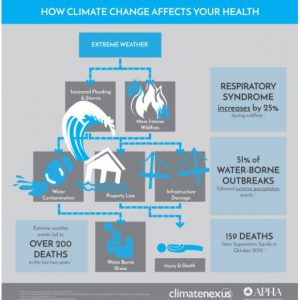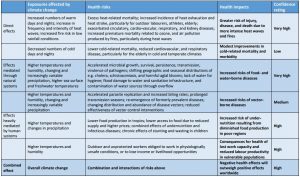
Introduction:
- According to IPCC (Intergovernmental Panel on Climate Change), Climate change refers to a change in the state of the climate that can be identified (e.g. using statistical tests) by changes in the mean and/or the variability of its properties and that persists for an extended period, typically decades or longer. For more details, please go to: https://publichealthnotes.com/climate-change-developing-countries/
- “Climate change is considered as a change of climate that is attributed directly or indirectly to human activity that alters the composition of the global atmosphere and that is in addition to natural climate variability observed over comparable time periods.” (UNFCCC)
- Disaster is sudden calamitous event which may be natural or manmade that is followed by huge damage to buildings, infrastructure and human suffering.
- Health is a state of complete physical, mental, and social well-being and not merely the absence of disease or infirmity (WHO)
Climate change induced disasters and health issues associated with it
- Climate change is the burning issues in today’s context. Increase in greenhouse gases from natural as well as man-made source have resulted in global warming, ultimately leading to climate change.
- Climate change is the one of the most crucial factor that is affecting the trend of natural disaster. Rise in sea level, rising temperature and other meteorological variables have brought about disastrous event/ disaster such as flood, drought, cyclone, epidemic infection, wildfire etc. throughout the world.
- According to data generated by Munich Re, the recurrence of climate related calamities like windstorms and floods have expanded six-times since the 1950s, while the recurrence of different sorts of disaster has risen just somewhat.
- It is estimated that since year 2208, about 22.5 million people are uprooted by climate related disasters (IDMC 2015).
- Catastrophes brought upon by climate change, for example, dry seasons in Somalia in 2011 and 2012, floods in Pakistan in 2010- 2012, and the earthquake in Nepal in 2015, can leave enormous quantities of individuals at risk without protection, clean water and essential supplies.
Flowchart for climate change, disaster and health

- Striking of disastrous conditions such as flood, drought, and wildfire will have fatal outcomes to health of people through causation of food borne illness, waterborne illness, vector borne illness, cardio-vascular problems, respiratory problems etc.
- Reports have made visible that climate change related disaster have huge impact on the mental health of people. Mental health problem such as depression, anxiety, fear, post-traumatic stress disorders have been report in people experiencing such disaster situation.
- Disasters lead to food insecurity among people leading to nutritional deficiencies.
- Problems of malaria, diarrhea, dengue, skin disease are common after the occurrence of climate induced disasters.
- According to WHO, each year:
- Under nutrition kills 3.5 million..
- Diarrhea kills 2.2 million
- Malaria kills 900,000
- Lack of sanitation, polluted environmental condition, contaminated food and water brought upon by the event makes people vulnerable to different infectious diseases and may also lead to breakout of epidemics in the community.
- Wildfire is another disaster induced by climate change. The communities near where wildfire occurred may also suffer from respiratory disease due to smog formation.


Brief explanation of climate change and disaster, and climate change and health effects is explained below:
Climate change and disasters
- Climate change invites multiple forms of disasters like droughts, floods, storms, and even bushfires.
- These disasters affect all countries globally, irrespective of the who caused it more or less.
- Natural disasters induced by climate change are rapidly increasing in last 2-3 decades and there are no signs of any limit to it
- This increase in climate change induced natural disaster clearly depicts the vulnerability of the future generation towards increased frequency and intensity of extreme climatic events
- Although all countries are affected by disasters, not all of them are equally suffering. Poor countries are the most vulnerable ones and epic sufferers as they deal with extreme cases especially related to droughts, floods, vector-borne and water-borne diseases, hunger and starvation.
Climate change and health effects
According to Intergovernmental Panel on Climate Change (IPCC) report, health effects of climate change can be divided into three major categories:
- Direct impact on health due to extreme weather events
- Impacts through environmental systems: increasing air pollution, food and water borne diseases, vector borne diseases
- Impacts through climate change interaction with social and human systems. Eg: health effects due to undernutrition, mental illness etc.
More description about the above-mentioned health effects is described in the table below:

References and for more information:
https://unfccc.int/files/press/backgrounders/application/pdf/press_factsh_science.pdf
https://www.iucn.org/content/climate-change-induced-disasters-and-gender-aspects-bangladesh
http://www.thelancet.com/journals/lancet/article/PIIS0140-6736%2806%2968079-3/fulltext
https://health2016.globalchange.gov/
https://tn.gov/health/article/climate-change
http://www.worldwatch.org/node/4127
http://www.unhcr.org/climate-change-and-disasters.html
https://www.apha.org/news-and-media/multimedia/infographics/how-climate-change-affects-your-health
https://www.nrc.no/what-we-do/speaking-up-for-rights/climate-change/
https://earthobservatory.nasa.gov/Features/RisingCost/rising_cost5.php
http://www.ipcc.ch/ipccreports/tar/wg2/index.php?idp=354
https://www.impactsworld2017.org/
http://www.unisdr.org/files/8918_RTCDisaster20Risk20Reduction20Concepts.pdf
https://en.unesco.org/themes/education-sustainable-development/disaster-risk-reduction
https://en.wikipedia.org/wiki/Disaster_risk_reduction
http://slideplayer.com/slide/5866313/
https://www.unisdr.org/we/coordinate/global-platform
http://www.preventionweb.net/english/hyogo/GP/
http://www3.ntu.edu.sg/rsis/nts/html-newsletter/alert/NTS-alert-sep-1001.html
https://en.wikipedia.org/wiki/Vulnerability
IPCC. Climate Change 2001, vol 1. Cambridge University Press (2001).
Bouma MJ, van der Kaay HJ. Epidemic Malaria in India’s Thar Desert. Lancet 373: 132-133 (1995).
Hales S, et al. Dengue Fever Epidemics in the South Pacific Region: Driven by El Nino Southern Oscillation? Lancet 348: 1664- 1665 (1996).
Kalkstein, L.S. & Greene, J.S. An Evaluation of Climate/Mortality Relationships in Large US Cities and the Possible Impacts of Climate Change. Env.Hlth.Pers. 105(1): 84-93 (1997).
Bouma MJ, et al. Global Assessment of El Nino’s Disaster Burden. Lancet 350: 1435- 1438 (1997)
http://www.who.int/phe/climate/conference_briefing_1_healthresilience_27aug.pdf
http://www.who.int/globalchange/climate/summary/en/index4.html
Contributor for this article: Ms. Rojina Tandukar. Ms. Tandukar is pursuing her degree in Public Health from a reputed University.